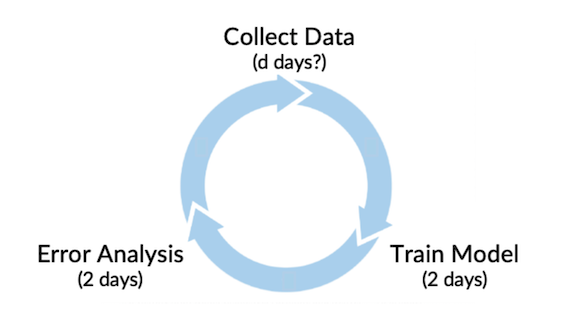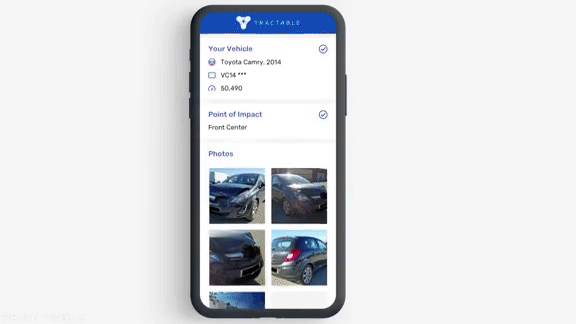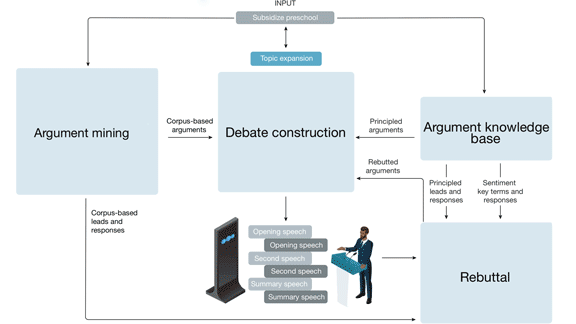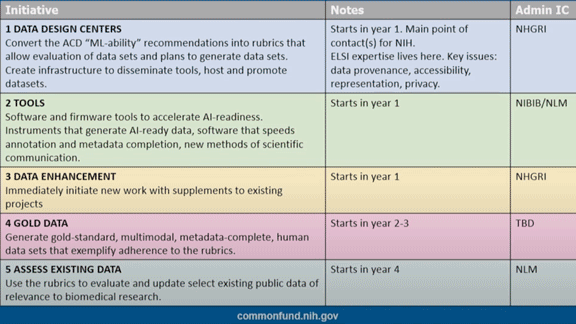Dear friends,
How much data do you need to collect for a new machine learning project? If you’re working in a domain you’re familiar with, you may have a sense based on experience or from the literature. But when you’re working on a novel application, it’s hard to tell. In this circumstance, I find it useful to ask not how much data to collect but how much time to spend collecting data. How many days do we need to collect m training examples?
Taking a data-centric approach to model development, let’s say it takes about two days to train a model and two days to perform error analysis and decide what additional data to collect (or how to tweak the model). How many days should you spend collecting data before training and error analysis? Allocating comparable amounts of time to each step seems reasonable, so I would advocate budgeting a couple of days — a week at most — for data collection. Then iterate through the loop.
I’ve seen many teams spend far too much data collecting data before jumping into the model development loop. I’ve rarely seen a team spend too little time. If you don’t collect enough data the first time around, usually there’s time to collect more, and your efforts will be more focused because they’ll be guided by error analysis.
Keep learning! Andrew
P.S. Once I created an unnecessarily scramble when asked a team to make sure that data collection took no longer than two days. Because of a bad Zoom connection, they thought I said “today.” Now I've learned to hold up two fingers whenever I say “two days” on a video call.
News
The Coming CrackdownThe European Union proposed sweeping restrictions on AI technologies and applications. What’s new: The executive arm of the 27-nation EU published draft rules that aim to regulate, and in some cases ban, a range of AI systems. The proposal is the first to advance broad controls on the technology by a major international body. What it says: The 100-plus page document divides AI systems into three tiers based on their level of risk. The definition of AI includes machine learning approaches, logic-based approaches including expert systems, and statistical methods.
Yes, but: Some business-minded critics said these rules would hinder innovation. Meanwhile, human rights advocates said the draft leaves loopholes for applications that are nominally prohibited. For example, face recognition is prohibited only if it’s conducted in real time; it could still be used on video captured in the past. Behind the news: Governments worldwide are moving to regulate AI. The U.S. Federal Trade Commission last week signaled its intent to take legal action against companies that make biased systems. A number of other countries including Australia, China, Great Britain, and India have enacted laws aimed at reining in big tech companies. Why it matters: The EU’s AI proposal is the spiritual successor to its 2018 privacy law, the General Data Protection Regulation (GDPR). That law sparked a global trend as Brazil, China, India, and other countries proposed or enacted laws to protect user data. The new plan could have a similar impact. We’re thinking: Despite its flaws, the GDPR drew a line in the sand and advanced the conversation about uses of personal data. While this new set of rules is bound to provoke criticism —some it valid, no doubt — we welcome moves to promote regulation around AI and look forward to a spirited, global discussion.
Wreck RecognitionAutomobile insurers are increasingly turning to machine learning models to calculate the cost of car repairs. What’s new: The pandemic has made it difficult for human assessors to visit vehicles damaged in crashes, so the insurance industry is embracing automation, Wired reported. How it works: When drivers get into an accident, insurance companies direct them to download an app that guides them through documenting the effects. These systems are particularly good at assessing damage from minor collisions and determining when a car has been totaled.
Yes, but: Several body shop owners said that automated estimates weren’t accurate and often failed to spot hard-to-see damage such as a misaligned frame. Bad estimates resulted in substandard repairs and delays as mechanics haggled with insurance companies for more money. Why it matters: Smart damage-assessment apps can inspect vehicles far more quickly than a human who examines the damage first-hand. Accurate output helps insurance companies save money and drivers settle claims more quickly. We’re thinking: Will self-driving cars that get into a fender bender use an app to assess the damage?
A MESSAGE FROM DEEPLEARNING.AI
Join us for “Climbing the Corporate AI Ladder,” a live virtual event, on May 5, 2021. Speakers from Facebook, IBM, and Microsoft will show you how to level up your career. Co-hosted by DeepLearning.AI and FourthBrain.
Up for DebateIBM’s Watson question-answering system stunned the world in 2011 when it bested human champions of the TV trivia game show Jeopardy! Although the Watson brand has fallen on hard times, the company’s language-processing prowess continues to develop. What’s new: Noam Slonim led a team at IBM to develop Project Debater, which is designed to compete in formal debates. Key insight: A debate opens with four-minute opening statements by both sides followed by rounds of rebuttals and finally closing statements. To perform well, a debater must quickly prepare arguments supported by evidence, address competing arguments, and organize statements logically — a set of tasks too diverse for an end-to-end system. Instead, the team built a pipeline of independent components, each a complex system in its own right. How it works: Project Debater receives a motion to argue in favor of or against. Then it’s off to the races finding facts, arguments, and counterarguments and stitching them together into speeches.
Results: Project Debater is the first system of its kind, and no established benchmark exists to evaluate it. The researchers compared the quality (judged by humans on a scale of one to five) of the system’s opening statement with a speech on the same topic generated by a GPT-2 pretrained on a large text corpus and fine-tuned on speeches. Project Debater achieved an average score of 4.1, far outperforming the fine-tuned GPT-2’s score of 3.2. Yes, but: Project Debater lost a 2019 competition with debate champion Harish Natarajan — albeit narrowly. Why it matters: Building a system that can beat humans at competitive debate isn’t a multi-decade, multi-team project like winning at chess or Go, but it’s a substantial endeavor. So far, Project Debater has generated over 50 papers and spawned the subfields in claim detection and evidence detection. We’re thinking: The AI community is embroiled in its own debates, including an annual event in Montreal. Maybe this system can participate next time around?
Boosting BiomedicineThe U.S. government aims to turbocharge biomedical AI research. What’s new: The National Institutes of Health, which invests $41.7 billion annually in medical research, announced a program called Bridge to Artificial Intelligence (Bridge2AI) to promote machine learning in human biology and medicine. Take it to the bridge: The program’s primary goal is to develop new datasets. It also aims to standardize data from different sources and develop automated tools to help create datasets and ensure that they adhere to FAIR principles, which aim to enable machines to use data with little human intervention. Bridge2AI will fund research into two areas:
Behind the news: U.S. government agencies bringing AI into mainstream healthcare.
Why it matters: Bigger, better datasets specially designed for machine learning could help illuminate human biological processes and the diseases that disrupt them. We’re thinking: AI for medicine has tremendous potential. Datasets designed specifically to help us realize that potential may be just what the doctor ordered.
Work With Andrew Ng
Data Analyst (LATAM): Factored is looking for a number of expert data analysts to work on projects involving analyzing datasets, gathering insights using descriptive modeling, and coding non-trivial functions. A strong background in mathematics and coding, specifically in Python or R, is also required. Apply here
Subscribe and view previous issues here.
Thoughts, suggestions, feedback? Please send to thebatch@deeplearning.ai. Avoid our newsletter ending up in your spam folder by adding our email address to your contacts list.
|




-1.png?upscale=true&width=1200&upscale=true&name=The%20Batch%20Image%20(2)-1.png)

